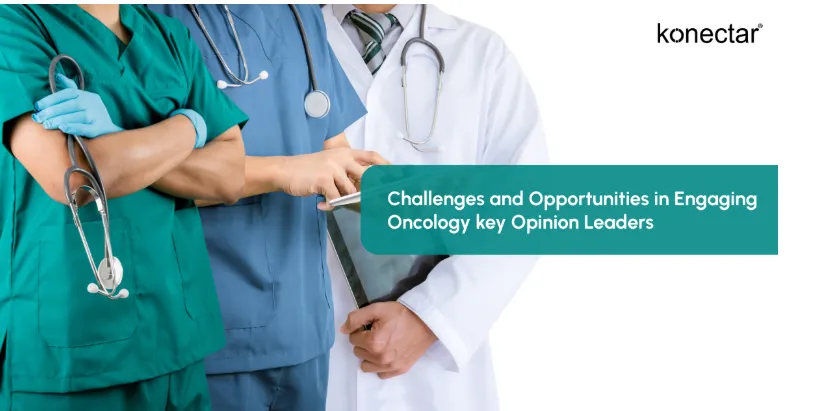11-08-2025
Challenges and Opportunities in Engaging Oncology Key Opinion Leaders

In oncology, the right voices don’t just inform, they inspire action. For years, that voice has belonged to the oncology key opinion leaders. These individuals are senior oncologists at the podium, principal investigators (PIs) of landmark trials, or authors of impactful studies. Their influence shapes treatment paradigms, drives clinical adoption, and builds trust in emerging science.
Today, these medical thought leaders in oncology share their insights beyond journals and podiums. They also contribute to digital health communication in oncology, leading conversations across webinars, panels, and collaborative research forums.
In some cases, their role overlaps with digital opinion leaders in healthcare. This is especially true when they share their insights through social media.
In This Article:
- Challenges in Engaging Oncology Key Opinion Leaders
- Opportunities in Effective Oncology KOL Engagement
- Best Practices for Successful Oncology KOL Engagement
- Navigating the Modern Oncology Engagement Landscape
- FAQs
Challenges in Engaging Oncology Key Opinion Leaders
Engaging oncology key opinion leaders brings undeniable value to medical affairs teams, but it's not without its challenges.
Identifying the Right Scientific Voices
Not every influential oncologist KOL is the right fit for a campaign or therapeutic initiative. Some might focus on diagnostics, while the team might be looking to collaborate for patient-centered cancer care.
Effective engagement begins with deep KOL profiling, evaluating publication history, involvement in clinical trials, and participation in oncology influencer engagement initiatives.
Building Authentic, Long-Term Relationships
KOLs appreciate thoughtful dialogue grounded in science. The days of one-off honoraria without purpose-driven collaboration are fading. Whether through virtual advisory boards in oncology or strategic guidance, the relationship must reflect shared goals and mutual respect.
Unlike broader healthcare digital engagement strategies that may target large groups, KOL engagement is highly personalized, anchored in context, credibility, and consistent communication.
Navigating Regulatory Boundaries
Working with KOLs (especially across regions) requires strict adherence to ethical and regulatory frameworks. Whether the interaction is part of medical education, advisory roles, or market shaping, transparency and compliant documentation are non-negotiable.
This is also true when online medical influencers make public statements that seem promotional.
Opportunities in Effective Oncology KOL Engagement
When done right, engagement with oncology key opinion leaders unlocks rich strategic possibilities.
Informing Strategy with Clinical Reality
KOLs offer unfiltered perspectives on real-world practice, helping teams understand unmet needs, treatment challenges, and patient behaviors. Their insights influence everything from trial protocol design to educational programming. Their expertise can be critical when exploring innovations like telemedicine in cancer care or patient engagement in oncology care.
Amplifying Scientific Education Through Trusted Voices
When KOLs lead or endorse content through digital platforms for oncology education, it drives credibility and peer trust. These initiatives are particularly effective when designed around high-impact content formats like expert roundtables, webinars, and clinical explainers.
Best Practices for Successful Oncology KOL Engagement
Align with Strategic Objectives and Scientific Rigor
Leading teams focus on researchers whose work and influence match their goals. They do not just partner with the most famous names. Co-developing meaningful initiatives, such as whitepapers, symposia, or treatment algorithms, yields long-term dividends.
Support Multi-Channel Thought Leadership
Today’s KOLs are multifaceted. Some are also digital opinion leaders in healthcare, active on professional platforms or speaking to the public through podcasts.
By enabling them to contribute to both traditional and digital spaces, life sciences teams ensure their reach extends across oncology professional networks, medical journals, and patient advocacy spaces.
Navigating the Modern Oncology Engagement Landscape
The oncology engagement model is evolving. It now blends scientific rigor with digital fluency. Digital transformation in oncology communication is expanding influence flows beyond keynotes and journals to virtual learning environments.
Pharma teams need to support this evolution. That means enabling collaboration, offering digital literacy support, and staying aligned with platforms where oncology key opinion leaders increasingly participate.
FAQs
- What’s the difference between a KOL and a DOL in oncology?
KOLs are recognized for academic, clinical, or scientific leadership. DOLs often rise to influence through consistent, digital-first peer engagement. Some experts operate as both.
- Why is KOL engagement critical for pharma teams?
KOLs offer scientific validation, advisory support, and peer education, helping to drive informed decisions.
- How can pharma ensure compliant engagement with KOLs?
Use clear contractual frameworks and ensure cross-functional collaboration across medical, legal, and regulatory teams.





